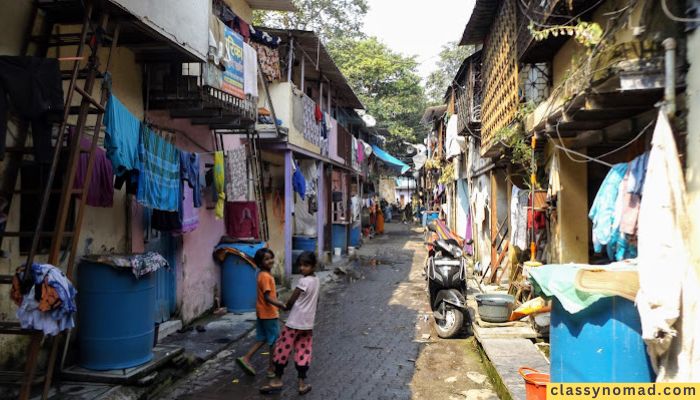Some Lessons Learnt from the Slums of Dharavi
Introduction
Nestled in the heart of Mumbai, Dharavi is often labeled as Asia’s largest slum. However, this characterization fails to capture the full essence of this unique urban area. Dharavi is not merely a slum; it is a vibrant community teeming with life, culture, and economic activity. This paper aims to delve into the dynamics behind the run-down and “unaesthetic” façades of Dharavi, highlighting its rich history, diverse population, thriving industries, and the resilience of its inhabitants. By exploring these aspects, we can achieve a deeper understanding of the hidden potentials of this urban mixed-use neighborhood.

Historical Roots
The history of Dharavi dates back to the late 19th century when it was a sparsely populated fishing village inhabited by the Koli community. The village was located on the northernmost tip of the island of Parel, adjacent to the Mahim Creek, which provided the fishermen with their livelihood. During the British colonial era, Dharavi underwent significant changes. The British built the Riwa Fort at Dharavi in the 18th century, and the reclamation of the swamps in the 1850s transformed the landscape. The Mahim Creek dried up, and the Koli community lost their source of livelihood, leading to the influx of migrants from various parts of India.
Evolution during Industrialization of Slums of Dharavi
The rapid industrialization of Mumbai in the early 20th century attracted waves of migrants seeking employment. Dharavi became a hub for these workers, providing affordable housing in close proximity to the industrial zones. The area transformed into a heterogeneous mixture of industrial and handicrafts, with fishing village huts and industrial sheds coexisting. Small-scale industries and businesses began to flourish, laying the foundation for what would become a bustling economic center.
Small-Scale Industries in Slums of Dharavi
One of the most remarkable aspects of Dharavi is its thriving small-scale industries. These industries contribute significantly to Mumbai’s economy and employ thousands of residents. The recycling industry, in particular, has gained international attention. Dharavi is estimated to recycle almost 80% of Mumbai’s plastic waste. Other notable industries include textiles, leather goods, and pottery. The Kumbharwada neighborhood, for example, is famous for its skilled potters and earthen pots. These industries not only support the local economy but also promote environmental sustainability.
Community and Resilience in Slums of Dharavi
Despite the challenges of living in a densely populated area with limited infrastructure, Dharavi’s residents have built a strong sense of community. The narrow lanes are filled with life, with children playing, artisans at work, and the aroma of street food in the air. The spirit of entrepreneurship and resilience is evident in every corner, challenging the stereotypical perception of slums. The community has also developed its own systems for basic services like water supply and waste collection. This sense of community and self-reliance is a testament to the resilience of Dharavi’s inhabitants.
Cultural Diversity
Dharavi is a melting pot of cultures, with residents from all over India. The community is home to people speaking different languages, practicing various religions, and celebrating a variety of festivals. This cultural diversity is part of what makes Dharavi so unique. Different communities within the slum have unique traditions, festivals, and cultural practices, yet they all coexist peacefully in the crowded lanes. Visitors on Dharavi slum tours often get a chance to experience this vibrant cultural life up close.
Dharavi Slum Tours
In recent years, Dharavi has become a popular destination for tourists. Mumbai tours and sightseeing now include slums of Dharavi as an essential stop, offering visitors a chance to understand the true essence of this vibrant community. Tour companies and travel agents conduct guided tours that aim to showcase the positive aspects of Dharavi, such as the thriving industries, the vibrant community, and the stories of success that have emerged from within its boundaries. These tours not only provide a glimpse into the daily lives of the residents but also contribute to the local economy.
Challenges and Future Prospects
Despite its vibrant community and thriving industries, the slums of Dharavi face numerous challenges. The lack of planned access to clean water and sanitation systems, poor health, limited education, and unemployment are significant issues. The area is also considered an illegal settlement, which means the government does not provide basic services. However, there have been efforts to redevelop Dharavi. The Adani Group, for example, is currently working on a project to rehabilitate the area. These efforts aim to improve the living conditions of Dharavi’s residents while preserving the community’s unique character.
Conclusion
Dharavi is much more than just a slum. It is a vibrant and resilient community with a rich history, diverse population, thriving industries, and a strong sense of community. By exploring the dynamics behind the run-down and “unaesthetic” façades of Dharavi, we can gain a deeper understanding of the hidden potentials of this unique urban mixite neighborhood. The story of Dharavi is a testament to the resilience and entrepreneurial spirit of its inhabitants, and it offers valuable insights into the complexities of urban development and community building.
